| Columns Retired Columns & Blogs |
Fussy with positioning. Fussy with system matching. Mediocre measurements. After all that still overly bright and fatiguing. This has been Bowers and Wilkins for a decade or more.
I used DRA Labs' MLSSA system, a calibrated DPA 4006 microphone, and an Earthworks microphone preamplifier to measure the Bowers & Wilkins 804 D4's frequency response in the farfield. My primary axis for the measurements was level with the tweeter, but I also performed a series of tests on an axis level with the midrange unit, which is 36" from the floor, the height of my ears in my listening chair. I used an Earthworks QTC-40 mike for the nearfield and in-room responses.
Bowers & Wilkins specifies the 804 D4's anechoic sensitivity as 89dB/2.83V/m. My B-weighted estimate was the same. The 804 D4's impedance is specified as 8 ohms, with a minimum value of 3 ohms. The solid trace in fig.1 indicates that the impedance magnitude, measured with Dayton Audio's DATS v2 system, lies between 3 and 6 ohms in the upper bass and midrange, with a minimum value of 2.55 ohms between 121Hz and 131Hz. The electrical phase angle (dashed trace) is occasionally high; for example, there is a current-hungry combination of 3.7 ohms magnitude and –55° phase angle at 87Hz. The effective resistance, or EPDR (footnote 1), drops below 2 ohms between 22Hz and 33Hz, 62Hz and 116Hz, and 663Hz and 886Hz. The minimum EPDR is 1 ohm from 88Hz to 110Hz and 1.6 ohms at 886Hz. The 804 D4 must be used with amplifiers that don't have problems driving 2 ohms.
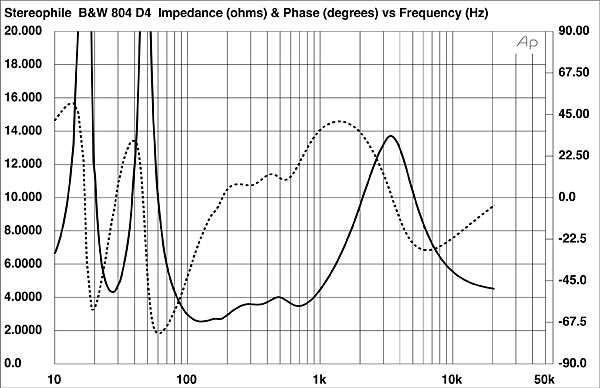
The traces in fig.1 are free from the small discontinuities that would imply resonances of some kind. When I investigated the enclosure's vibrational behavior with a plastic-tape accelerometer, all the panels were relatively inert. The only resonant mode I found was on the sidewalls at 355Hz (fig.2), but this is very low in level and has a high Q (Quality Factor). (The higher the Q of a resonance, the lower the possibility that it will be excited.)
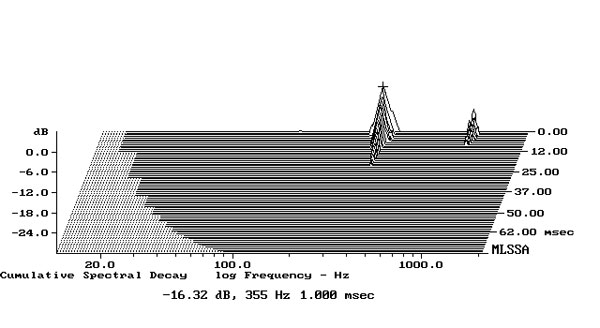
The blue trace below 350Hz in fig.3 shows the sum of the nearfield outputs of the two woofers, which behave identically. The minimum-motion notch in their outputs, which is when the back pressure from the port resonance holds their diaphragms stationary, lies at a low 28Hz, which coincides with the center of the saddle in the low-frequency impedance-magnitude trace. The red trace shows the response of the downward-firing port, measured with the microphone capsule inserted into the space between the flared port opening and the aluminum bottom plate. The port's output peaks at the tuning frequency in textbook fashion, but its upper-frequency rolloff is disturbed by two high-amplitude, high-Q peaks, at 308Hz and 567Hz. Peculiarly, this behavior doesn't have any effect on the output of the woofers. All I can think of is that the resonances that cause these two peaks occur in the airspace below the port opening. In any case the fact that the port faces the floor—together with the peaks' high-Q—should minimize the audible consequences of this behavior.

The output of the woofers crosses over to the midrange unit's output (fig.3, green trace below 4kHz) around 450Hz, with a steep high-frequency rolloff. The response of the midrange unit, measured on the tweeter axis, appears to be a little lower in level than that of the tweeter; their combined output is disturbed by a small, narrow peak just below 4kHz and a suckout between 5kHz and 7kHz.
The black trace below 300Hz in fig.4 is the complex sum of the Bowers & Wilkins's nearfield woofer and port responses. The peak in the upper bass, which is due in part to the nearfield measurement technique, is not as fully developed as usual. From my auditioning, I suspect that the woofer alignment is somewhat overdamped, favoring articulation over ultimate low-frequency extension.
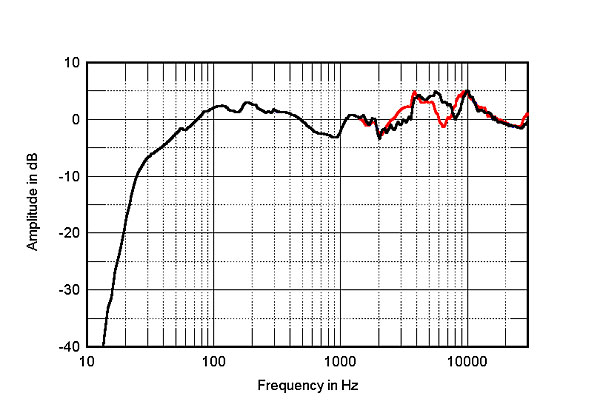
The red trace in fig.4 shows the 804 D4's farfield response, averaged across a 30° horizontal window centered on the tweeter axis; the black trace shows the farfield response, averaged across a 30° horizontal window centered on the midrange axis. Like the 705 Signature, both traces have an excess of energy between 3.5kHz and 15kHz. However, the suckout between 6kHz and 7kHz on the tweeter axis fills in on the midrange axis to be replaced by a smaller suckout centered on 8kHz. The responses in fig.4 were taken without the small grilles; repeating the tweeter-axis measurement with the grilles resulted in very little change. Commendably, both samples' frequency responses matched within 0.5dB.
Fig.5 shows the 804 D4's horizontal dispersion, normalized to the response on the tweeter axis, which thus appears as a straight line. The contour lines in this graph are smooth and evenly spaced, correlating with the stable stereo imaging I noted in my auditioning. There is a slight lack of presence-region energy to the speaker's sides, while the ridge of off-axis energy at the cursor position reveals that the on-axis suckout in that region tends to fill in to the 804 D4's sides. In the vertical plane (fig.6), the mid-treble suckout in the Bowers & Wilkins's response fills in as expected on the midrange axis. A notch at 4kHz appears 15° above the tweeter axis, which suggests that this is the crossover frequency between the midrange unit and the tweeter.
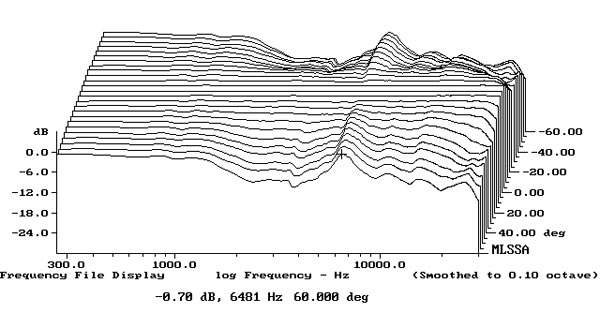
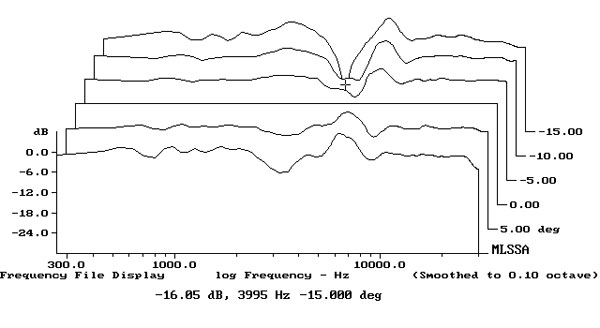
The red trace in fig.7 shows the Bowers & Wilkins 804 D4s' spatially averaged response at their final positions in my room. (The spatial averaging (footnote 2) tends to average out the peaks and dips below 400Hz that are due to the room's resonant modes.) For reference, the blue trace shows the spatially averaged response of the PSB Synchrony T600s, which had some of their ports blocked, as I discussed in my review in the November 2021 issue. The Bowers & Wilkinses excite the lowest frequency mode just above 30Hz in my room to a greater extent than the PSBs and have less output in the upper midrange. While the T600s have the usual gentle downward slope in the top two audio octaves (footnote 3), I did find their highs to sound somewhat mellow. By contrast, the 804 D4s have greater output in the mid-treble, which is what I heard.
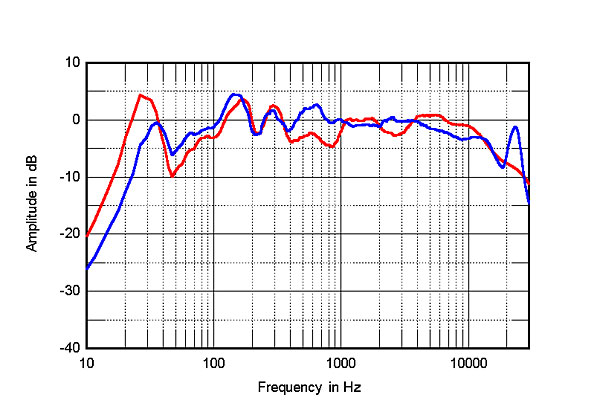
In the time domain, the 804 D4's step response on the tweeter axis (fig.8) reveals that all the drive units are connected in positive acoustic polarity, with each drive unit's step smoothly blending with the start of the next-lower-in-frequency unit's step. The 804 D4's cumulative spectral-decay plot on the tweeter axis (fig.9) is clean in the midrange and treble but is marred by a ridge of delayed energy at 3.8kHz, the frequency of the narrow peak in the farfield response.
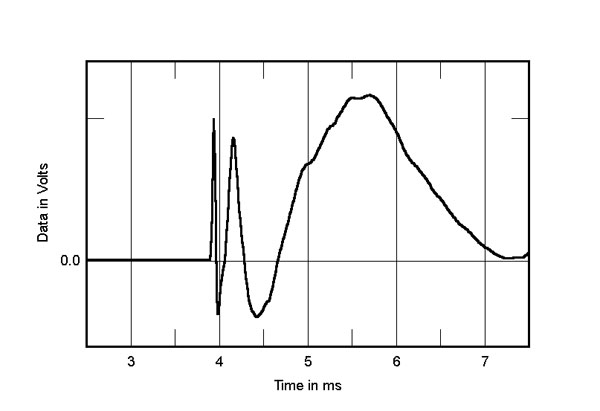
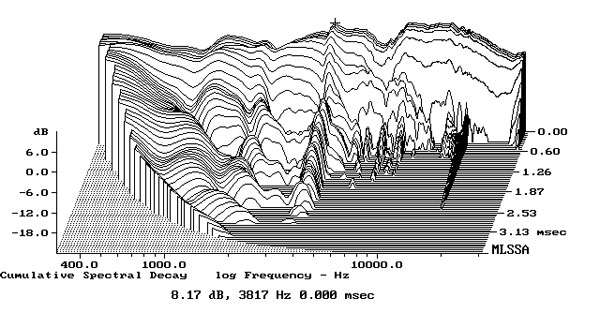
The Bowers & Wilkins 804 D4's measured performance is enigmatic, with positive aspects—the relatively high sensitivity, the superbly quiet enclosure, the well-controlled dispersion, and the excellent pair matching—that must be set against others, like the demanding impedance, the excessive high frequencies, and the resonances in the port's and upper-frequency units' output.—John Atkinson
Footnote 2: Using the FuzzMeasure 3.0 program, a Metric Halo MIO2882 FireWire-connected audio interface, and a 96kHz sample rate, I average 20 1/6-octave–smoothed spectra, individually taken for the left and right speakers, in a rectangular grid 36" wide by 18" high and centered on the positions of my ears.
Footnote 3: A loudspeaker that offers a flat on-axis response and well-controlled lateral dispersion gives a gently sloped-down treble in its spatially averaged room response due to the increased absorption of the room's furnishings and the narrowing of the tweeter's radiation pattern at high frequencies.

I always study the measurements first before reading any subjective reviews.
Cheers George

John Atkinson
Technical Editor, Stereophile

Hi
If I were to buy any audio, I would not read anything, specs & reviews irrespective. I always audition first with my own ears.
You may trust the measurement date & whoever critics' ears. Sorry, I trust my ear ONLY. period. Cause I pay with my hard-earned money.
Listening is believing
Jack L

Measurements can tell you important things, provided you understand how measurements match up with your personal taste and usage.
Measurements can also alert you to things that might become apparent later on but that you might not notice in a short audition, or when auditioning in a shop rather than your own home.
Learn to make measurements work for you. It will lead to better decisions in the end than listening alone. I bought my last two DACs (NAD M51; Topping D90SE) virtually on measurements alone, though I also read multiple reviews of the NAD. I loved it. When I saw that the Topping measured even better, I bought it. I love it too, and it's what I use now. I didn't have to listen or even read any reviews. Just saw the measurements.
The NAD M32 amplifier measurements looked good in some ways, but very strange in other ways. It sounded like crap. Those weird measurements should have raised questions in my mind, but unfortunately I trusted the reviewer. Again, measurements could have tipped me off ... if I'd paid attention.

Hi
Well, first off I never heard the sound of NAD M32 which tagged for $3,999. I do not know how good or bad it would sound.
Yet J.A. "highly recommended" it. Stereophine also recommended it as 2021 recommended D/A integrated amp.
You are comparing yr $899.99 Topping D90SE D/A with preamp out vs NAD D/A with built in integrated amp,
So apple vs orange ! It is a fair comparison ????
You blamed the crapy sound of NAD-M32 was due to its "very strange" measurement data.
You really think your ears were so powerful to hear the crappie sound of yr NAD M32 due to its "very strange" measurement data ??
So either there was a problem with the ears of yours or of J.A. who "highly recommended" it.
Jack

"You are comparing yr $899.99 Topping D90SE D/A with preamp out vs NAD D/A with built in integrated amp,"
I did not make any such comparison. Maybe you need to learn to read English as well as learning to read measurements.


My god in these times I have
Never come across such anal retention and obsessive compulsive
Material,billion dollar babies!
More money than sense,if this is musical enjoyment well I guess I've been blissfully unaware of a community obsessed by materialism and price.... shocking and the marketing equally ridiculous.Never feel guilty taking money from mugs
Chasing the unattainable.
Shameful capitalism and the same old
Reviews with all your reference recordings.


Can you expound further?


If Paradigm can get back to their roots of making speakers that measure good, surely B&W can. The large diameter mids drive me batty, and the tweeter? If Vivid can do a tapered tube with a flat response, I don't see why B&W can't.

Hi
What does "making speakers that measure good" to do with the same sounding good to our ears ??
Listening is believing
Jack L

I've enjoyed my 805 D3s--siblings not too far removed--for several years. But both the strengths and the challenges described above ring true to me. Thanks

Very useful review, thank you.

“ … you need to audition”. No, I don’t. Nor any other model from this high-end pretender. I heard many models over the years and it is mid-fi at best. Still… spending a lot of advertisement money, will get you a “reasonably favourable review”. That I will give them.

Hi
Really ?????
So from yr having "heard many mdoels over the years", please enlight us on what brands/models YOU'd consider Hi-Fi.
Alas, I am still a PROUD owner & LOYAL lover of "mid-fi" loudspeakers. made in England. Too bad.
Listening is believing
Jack L

Hi Jack,
I also own an English speaker, the Kef 207/2. I have little desire to upgrade. Kef is what B&W would like to be but just doesn’t manage to become. If I were to upgrade I would like to get an Acapella speaker like the Atlas model. This seriously beats my kef. But Jack, I kind of regret my remark because it was never my intention to lessen someone’s choice of gear. Take care, enjoy our mutual hobby. I will too especially since we entered another lockdown here in the Netherlands as from today. Have a nice Christmas.
Cheers Wim

Hi
Sorry, I think we are not on the same page.
Now you've told us yr ideal loudspeakers are $117,500 Altas hybrid horn loudspeakers made in Germany vs $12,500 B&W cone loudspeakers made in England. 10 times price difference !!!!!
Like you were comparing a $121,000 Porsche 911 Carrea 4 with a Toyota Corolla !!! Major League ballgame with junior league !!!
For horn loudspeakrs ??? Thanks but no thanks for me, my friend.
I won't take any horn compressor driver speakers even for a penny !
Why? Compressor-driven horns get some distinct hornlike colouration. Any music will sound horny even a soprano! IMO. My skeptical ears get zero tolerance against tonal coloration.
Likewise, I prefer MM phono cartridges vs MC cartridges due to the distinct tonal colouration of MC cartridges.
Be my guest if you like horn loudspeakers. My skeptical ears just can't handle them.
Listening is believing'
Jack L

Hi
Right on, my friend.
Thanks but no thanks to the new extremely contageous variant
virus: Omnicron !
My entire city has entered again in lockdown this morning: indoor asssemby not over 10 people. Outdoor not over 25 !
What a shame !
Jack

Are there any Audio Products that we don't need to audition ? ( I've liked every Magnapan design, so I'd guess that I probably wouldn't need to audition em if the price was right )
Paul at PS Audio is say'n their NEW loudspeakers are better than his IRS V5 that I think you once had some exposure to, I'm hoping you get to evaluate them and then recommend that we all go out to audition them.
You still own a pair of 801s after all these decades?, wow! Do you have the matching hoods that are kinda ugly ? I imported and sold those things, the 802s were farrrrrrrr more popular.
Tony in Florida

Hi Tony--
"You need to audition" is spot on--in two directions. You need to audition these because they are top tier speakers from one of the great names in hifi--your search would not be complete if you ignored them. But also--you need to audition because these speakers have characteristics that may be a problem for you--do not just accept them on reputation, caveat emptor.

A good stating point. A couple of questions though. First - which ear is it that you trust most , your left or right ear? Second. is your choice of ear predetermined by something as mundane as a hearing test- so that you know which ear to listen with?

I recently went for one. I have 1.7% hearing loss in my left ear and 0.9% loss in my right ear. This was something of a relief as it confirmed my instinctive bias to turn my head slightly to the left (thereby accentuating the quality of my reception) when listening in the sweet spot.

We need to understand that a transducer system doesn't demand/require a blockBuster Powerhouse Amplifier fully capable of delivering considerable Current to loads down in the low impedance levels like the Thiel CS3s I used to sell. We had to demo those things with 200 horsepower Mono Amps that would double down in capability as they dropped below 4 ohms. Egads they sounded good with powerhouse Electrocompaniet Amplification but didn't do well with the Big Conrad-Johnson Premier Tube Amplifiers.
Measurements are critically important for people that can interpret the concept behind the design.
Mr.JA has consistently earned the "Audiophile of the Year" designation for these last 4 Decades. He might be a kind of Vanilla in the things he does and writes about but he's the best Vanilla we ever got.
Mr.HR, the Audiophiliac, Stereophile's Canadian writer and Mr.KM might be our up & Coming revealers of wonderful insights but we still need the technical matters properly described and contextually revealed.
Stereophile grew Into a great institution but without Mr.JA it probably would've just been another promotional Glossy
with glitzy snaps of Car Priced Record Players on the Covers.
Tony in Florida


Mr.JA has consistently earned the "Audiophile of the Year" designation for these last 4 Decades. He might be a kind of Vanilla in the things he does and writes about but he's the best Vanilla we ever got.
Thank you, Tony.
John Atkinson
Technical Editor, Stereophile

I love to look at the last sentence of each measurement section JA1 writes and I read it as though Juan Antonio Samaranch is saying it. That sentence is JA's way of telling us what's really up.
Samaranch used to end each Olympics with a summary sentence that represented his view of how well the games went off. His schtick was...when giving the president's address at the close of each Summer Olympics, to praise the organisers at each Olympiad for putting on "the best ever" Games. But, he was fond of working in variations on that to give his true opinion, especially for 1996!
So, anyway, keep up the great work, JA1, will will continue to ruminate on each review's last sentence.

John Atkinson, please provide your opinion on B&W 804 D4 vs. 804 D3 speakers. Considering buying used B&W 804 D3 speakers. Thanks.

Methinks the pronounced treble or high frequencies still present, looks like fussy placement

Opinions are like belly buttons, they say.
Specs and a reviewer's take are but two helpful inputs to consider. In this case, JA's perception was very close to mine (of the 804 d3 I own). I have disagreed with him on other reviews, but I have a ton of respect for him and his contributions.
I recently listened to the 804 d4 in a showroom and was less impressed in some ways vs the d3 but that should be expected because of the variables at play. The room setup at the store was not ideal.
I passed on several "flat" speakers and ended up with the "tailored" 804's. In my room, on my system, with my ears, at my listening levels and my recordings the 804's are simply amazing.
I look forward to the day we can look at specs and determine how something will sound (in our room?). In the mean time, I remain convinced there are qualities we simply have not figured out how to measure and enjoy the writings of guys like JA. I'm VERY glad all speakers don't sound the same. In the end, they are all pretty far from the real thing.
Happy Holidays, all.

Hi
Too true. But what better choice we music lovers will get instead of going to attend live concerts personally - time & money.
Considering the crazy pandemic going on worse & worse ! Public gathering is banned nearly everywhere.
Alternative is always something else from the real thing. Take it or leave it.
Jack L

Please provide your opinion on B&W 804 D4 vs. 804 D3 speakers. Considering buying used B&W 804 D3 speakers. Thanks.

I own the D3 and have listened to the D4 in two different rooms. Not a huge difference in terms of character. Tight bass that can fall on the lean side if pulled out into the room. The biggest difference is in the midrange that is less forward (closer to flat) than the D3. Top and bottom end sounded about the same. Not a great speaker for metal music or bright/thin recordings from the 80's, but great for all other genres. The D3 will work best when placed closer to the front wall. They will work best in a mid-sized room. Not sure if the D4 is the same with the relocation of the port. The D4 is the better speaker but you will pay 3x for it. For the ~$6k used ones are getting, the D3 is an AMAZING value. The better the amplification and the more power, the better. The "revealing" nature of this speaker will announce any shortcomings in your rig. They pair best with less forward gear like Mac or Musical Fidelity. Mark Levenson would NOT be a good match. They may be too bright if your room is highly reflective. This all assumes you are using them for 2-channel audio. Hope that helps.

Finally, scientific measurements by Audio Science Review (ASR). Yes, all speaker wire is the same. Humans can't tell the difference between coat hanger wires and $1000 cables. Stereophile has endorsed snake oil for decades now. But Roger Russel of McIntosh said that 30 years ago, the audio rags couldn't turn down the ad money. So glad Amir puts these old subjective (financially endorsed) ears to rest. High prices and advertisements no longer rule the hobby, the JUDGE has finally arrived, and as we know, most of these reviews are crap.

ASR has interesting information, yet their conclusions are no more or less reliable than any other. I purchased one of the most respected (Okto Research) and most panned (BorderPatrol) DAC's on ASR forums. You would think there would be a huge difference. There is not and I can not say for sure that everyone would pick the Okto DAC over the Border Patrol. My point is, use YOUR ears. ASR, unfortunately is no more the Rosetta stone than Stereophile. I respect the work of both but there are many more trolls on ASR who are convinced they know everything there is to know. At least Stereophile has some humility about what is "best."

Well, you shouldn't expect a huge difference from among the components that are the easiest to get right, a DAC. Basically any of the top 20 measured DACs should be fully transparent, the fault likely instead lies in your loudspeakers / headphones which are far less accurate and clean.
Also, most recordings are not exactly great, so obviously even vinyl can sound terrific

John Atkinson, please provide your opinion on B&W 804 D4 vs. 804 D3 speakers. Considering buying used B&W 804 D3 speakers. Thanks.